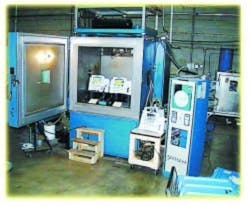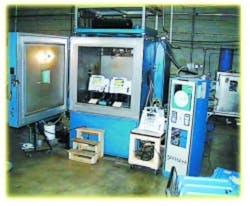Environmental Tests Cost Less Than In-Warranty Repairs
How will the product that you designed, built, and tested fare in the environments of the real world? For the answer, go to specialists at an environmental test laboratory who know how customers use products and who have the facilities to create the same conditions in controlled environments with you looking over their shoulders.
The environmental testing laboratory with its temperature and humidity chambers, multiaxis vibration, high-amplitude acceleration, and drop tests is not familiar territory for most equipment designers. By the same token, environmental testing laboratory personnel probably don’t use ball grid arrays, systems-on-a-chip, built-in self-test devices, and other complex electronic equipment.
A product designer and the environmental test specialist need to find a common ground for communications. This article is a step toward that goal as it looks at what testing laboratories can do to help design engineers as they prepare their products to meet the real world.
Dynamic Tests
One of the basic tools for environmental simulation is the vibration table. The well-equipped laboratory can provide sine, random, sine-on-random, or random-on-random vibration. Bell Technologies, for example, has 15 vibration tables ranging from 1,500 force lb to 15,000 force lb.
Most facilities can simulate various levels of shock on your test sample. Elite Electronic Engineering tests to 300g, for example.
Acceleration is simulated by spinning your assembly or subassembly on a centrifuge. Bell Technologies has the capability to handle base plates up to 20² × 24².
Climatic Simulation
Temperature and humidity are simulated in chambers of many sizes. For example, Bell Technologies and Elite Electronic Engineering have assorted sizes including walk-in units and can simulate temperature excursions of 400°C or greater at a relative humidity of 20% or lower and up to 95% or higher. National Technical Systems even has a 25¢ × 25¢ chamber. Since temperature/humidity testing often involves operation of the product in the test chamber, lab personnel can make arrangements for you to operate the controls and see the displays without being imprisoned in the test chamber.
“Sometimes we build specialized setups for thermal shock tests,” said Jeffry Schutt, general manager of Trace Laboratories-Central. “In one arrangement, we automated movement of the test sample in and out of a freezer. In another, we simulated the repeated transfer of samples from a dishwasher environment to a freezer environment and back.”
Since your products may be exposed to rain, dust, or salt spray, a test lab also can simulate those conditions to evaluate their survival in a rain forest, the Mojave desert, or on the deck of an Aegis-class vessel in a typhoon. Corrosion is another potential hazard for the product. A test laboratory can help you plan a test sequence to discover whether your products can withstand that threat as well.
HALT/HASS
Several laboratories offer highly accelerated life testing (HALT) and highly accelerated stress screening (HASS). For example, Bell Technologies has equipment and personnel in the Burlington, MA, and Mountain View, CA, locations for these services. Stephen Fratto, sales engineer, explained, “These procedures combine extremes of temperature, multiaxis vibration, and rapid thermal transitions to detect design problems or areas of component or manufacturing weakness. We can handle payloads up to 250 lb with vibration levels to 50g. Temperatures range from -100°C to 150°C, with change rates of 60°C/min.”
QualMark has a 48² × 48² vibration table in Boston for HALT/HASS testing and 30² × 30² tables at several other locations. The thermal system in each laboratory has a temperature range of -100°C to 200°C and can change at 60°C/min. Random vibration spans the 2-Hz to 10,000-Hz range with excitation in three linear axes and three rotational axes at up to 45g rms.
“Our laboratory in Detroit has two 30² × 30² tables and two 18-ft3 thermal chambers that operate from -40°C to 150°C,” according to Neill Doerten-bach, QualMark’s OVS technical sales manager. “We also offer HASS with temperatures to 120°C, pressure to four atmospheres, and relative humidity to 85%. This chamber can reduce typical test times by a factor of 100.”
Packaging Tests
Trucking lines, railroads, airlines, parcel delivery companies, the postal service, shipping-dock workers, and stockroom clerks put environmental stresses on your product every day for no extra charge. In effect, shipping a product commercially will show you how it fares under the stresses of vibration, shock, and compression.
Fortunately, environmental testing laboratories know the range of these shipping environments. They can simulate them suitably to predict how well a product will fare as it is sent across the tortuous path between your shipping department and the customer’s hands. In the laboratories at Bell Technologies, for example, various levels and modes of air, rail, or truck vibration; a baggage-handler’s 48² drop; or a stevedore’s stacking punishment can be simulated.
Test Standards
Some laboratories are geographically and technically positioned to specialize in specific testing. This may include the military market, space systems, or automobiles. Other laboratories have several locations, making it possible to specialize in many local markets.
National Technical Systems has more than 300 environmental test chambers in 17 locations. All the sites have the basic temperature, humidity, vibration, shock, and acceleration test capabilities, but several are equipped to serve specific regional technologies. For example, facilities at Fullerton, CA, and Boxborough, MA, have new 3-m semi-anechoic chambers, and the western laboratories offer earthquake simulation.
As you might expect from their location, Detroit Testing Laboratory has a depth of experience with automobile manufacturers. Tim Geiger, the materials testing group manager, said, “We test to commercial test specifications, including several from Daimler-Chrysler, Ford, and General Motors. Our broad selection of facilities includes two 32-ft drive-in chambers for programmable temperature/humidity tests. We can go from -55°C to 104°C at 20% to 98% relative humidity and run a thermal shock test in the -73°C to 200°C range.”
Looking at a laboratory’s list of specifications that it can accommodate, you can determine the probable capability to handle your product. You will find reference to ANSI, ASTM, Bellcore, IEC, ISO, and ISTA standards. Several labs test to the various MIL-Specs, such as 167 and 202. Then there are NEMA, SAE, and UL references.
Documentation
Quite possibly, the laboratory you choose has experience in providing test documentation to meet most every situation. The simplest proof of successful test is the one-page certification, suitable in many cases. One step up is a letter outlining the basics of the test and confirming that the product passed. If you need a formal report, the lab usually can provide it in whatever format and detail you require.
Other forms of documentation are negotiable. You may need still photographs or videos or the information on electronic media.
Engineering Support
Many environmental test specialists can offer engineering support when a problem is discovered. The laboratory specialist doesn’t know the details of your product design, yet understands what has happened to other products subjected to the same environments. By pooling your talents, the problem usually can be resolved quickly.
“Even if the design engineer doesn’t request it, we always conduct a root-cause investigation,” said Mr. Schutt of Trace Laboratories. “This is absolutely critical in enabling us to determine whether the problem is in the product or the test implementation. In conducting the investigation, we learn a great deal about design margins associated with the product and can make suggestions to the designers regarding possible ruggedization techniques.”
On a HALT program, the purpose of environmental exposure is to cause failures. Here too, the laboratory personnel often have helpful suggestions based on previous HALT experience.
Special Applications
While many environmental tests are routine, sometimes an unusual problem surfaces. Since the types of products they deal with change almost daily, laboratory specialists have experience in dealing with sometimes unusual challenges.
“Our engineers built a system to evaluate diesel glow-plug control systems for a military application,” said Steve Laya, sales and marketing manager at Elite Electronic Engineering. “The equipment was operated at five temperatures and four voltage extremes.
“Sets of eight glow plugs were operated at a specific distance from optical pyrometers while our software automatically simulated 50,000 start sequences and monitored glow temperature, voltage, and current. We also subjected the devices to vibration, shock, and water immersion,” he continued.
One customer needed to run temperature-cycling tests on 13,000 electronic assemblies to evaluate the reliability of solder joints. “We worked with a test equipment manufacturer to adapt their equipment to handle this test program,” said Mr. Schutt of Trace. “New harnesses and wiring schemes were developed, and we wrote software to monitor what was happening in the several temperature chambers during the two-month sequence. The net result was a detailed report that enabled our customer to validate the long-term reliability of their new consumer product.”
One manufacturer was concerned about quality problems that showed up in vibration test. John Alba, the environmental lab manager at Quest Engineering Solutions, recounted: “We bought used vibration equipment and refurbished it. Then we developed a 100% test sequence for the customer to use on its production line as part of a burn-in process. This is a version of the HASS technique to weed out defective products.”
A key element in vibration testing is the fixture. “A recent customer in our Denver laboratory had problems,” Mr. Doertenbach of QualMark noted, “and we were able to make an on-the-spot modification that worked well. The main parts of the modification were two Vise-Grips™.”
Acknowledgements
The following companies supplied information for this article:
| Bell Technologies | 800-775-2550 |
| Detroit Testing Laboratory | 810-754-9000 |
| Elite Electronic Engineering | 800-354-8311 |
| National Technical Systems | 800-723-2687 |
| QualMark | 303-254-8800 |
| Quest Engineering Solutions | 978-667-7000 |
| Trace Laboratories | 847-934-5300 |
Published by EE-Evaluation Engineering
All contents © 2000 Nelson Publishing Inc.
No reprint, distribution, or reuse in any medium is permitted
without the express written consent of the publisher.
October 2000

